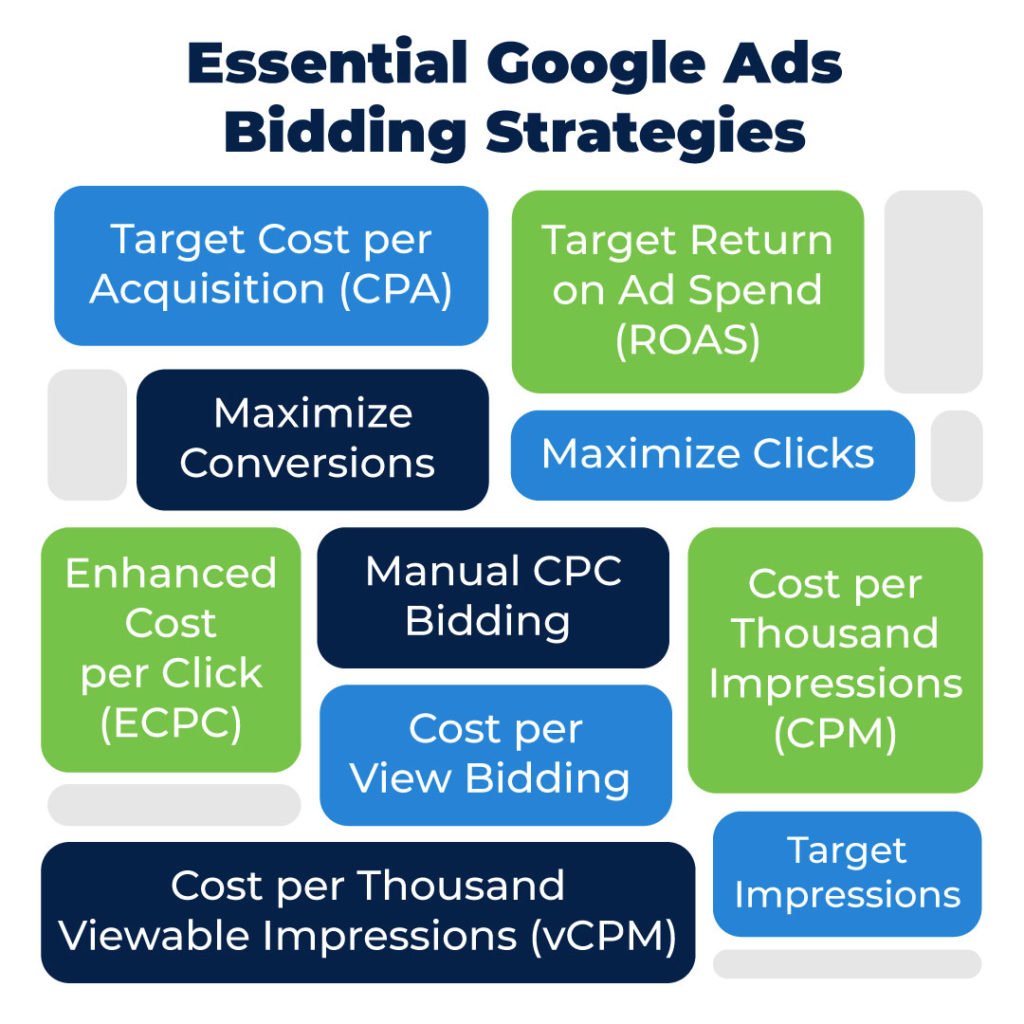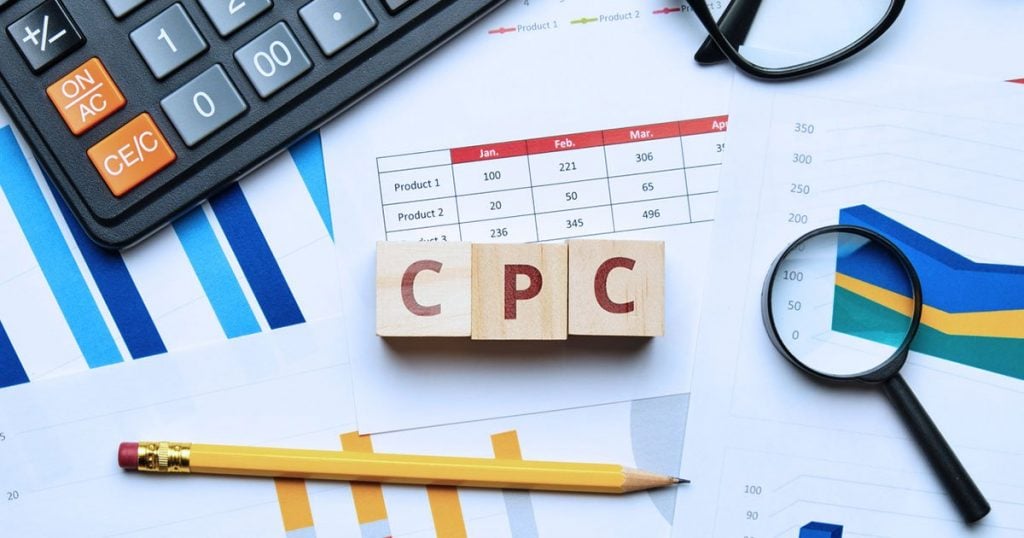With so many options for automated bidding available, Google Ads can leave you wondering which overall bidding strategy will give you the best results. By making wise choices, you get vast improvement in your ad campaigns. A few poor decisions about Adwords bidding could cause a huge dent in your ad budget.
Google periodically comes out with updates on bidding features. If you’re not keeping up, your competition might be. If you’re not as familiar with smart bidding as you’d like to be, you’ve come to the right place.
We’re going to walk you through 10 of the best bidding strategies so you get the best results from your ad campaigns.

Strategy 1: Target Cost Per Acquisition (CPA)
Let’s begin with target cost-per-acquisition (CPA), which is a valuable strategy for optimizing conversions. With this Google Ads bid strategy, you set the amount you want to spend for a single conversion. Google’s algorithm sets your bids according to your parameters to produce as many conversions as possible.
The CPAs may end up being slightly above or below your target CPA, but don’t worry, the numbers usually balance out in the long run. You can set your target CPA at either the campaign or portfolio level and let Google adjust the keyword level bids accordingly.
Advertisers will set caps to make sure Google doesn’t adjust too high or too low, and that’s the kind of flexibility you don’t get with individual campaigns. Bear in mind, you’ll need a bit of history on your campaigns for them to perform well. Google likes to see at least 30 conversions over the course of a month before you get started.
Strategy 2: Target Return on Ad Spend (ROAS)
Target return on ad spend (ROAS) works along the same lines as target cost per acquisition. The main difference with this bid strategy is that Google’s algorithms will use your history to make predictions about future conversion and conversion value performance. The bidding adjusts in real-time to get the best conversion rate and reach the goals you set at ad group, campaign, or portfolio levels.
Again, the individual ROAS will vary per conversion, but Google will try to balance it out in the end. You have the ability to set minimum and maximum bid limits at the campaign or portfolio levels which can help keep your budget in check. Just know that it could have a negative effect on the decision-making algorithms.
Here’s another tip — you’ll need a greater number of conversions (around 50 within the last month) than for target CPA, and you’ll also need to track revenue or value for your conversions to know how well it’s working.
Strategy 3: Maximize Conversions
One of the most straightforward Google Ads bidding strategies is maximizing conversions — a bidding strategy that’s fully automated. You simply set your maximum daily budget and Google will be off and running, bidding on your behalf with the goal of getting as many conversions as possible from your daily budget limit. Google won’t factor in any individual keywords set by advertisers, and your bids will be based on goal outcomes.
The best CPC strategy for maximizing conversions is to set a reasonable daily budget amount, check your ROI at the end of the campaign, and determine whether the strategy increased your profit margin. For best results, you want to have some conversion history, even if it’s minimal.
Strategy 4: Enhanced Cost Per Click (ECPC)
The main benefit of enhanced cost per click is that you get the ease of automated Ads bidding without having to give all the control to Google. Also, you won’t need large amounts of data to get it going which makes it a viable strategy regardless of your ad budget.
All you have to do is set the CPC for your ad groups and keywords. Google will adjust them based on the likelihood of a conversion. If your CPC rate starts to climb too high, Google may lower your bid to decrease your costs for low-converting ads, and they’ll try to average it out at the maximum CPC settings.
One of the nice things about ECPC is that you can set bids based on a flat number of conversions or optimize for the value of conversions. For that to work, you need to create different Google Ads conversions of varying values or you’ll need dynamic conversion events where you can follow the total value of a sale.
Strategy 5: Maximize Clicks
If one of your goals is to drive a large volume of traffic to your site, maximize clicks is a good Google Ads bid strategy to try. It’s also a good smart bidding strategy if you have a limited search volume for keywords or a limited budget.
This strategy is based on your maximum daily budget and Google will work to drive as many clicks as possible to your site. You get to set the maximum CPC limit to keep your budget in line. Be aware that this bidding strategy doesn’t look at the quality of the traffic, and it’s not the best strategy out there for driving conversions.
Strategy 6: Manual CPC Bidding
Any marketer will tell you that there are pros and cons to manual CPC bidding. The biggest advantage is that you get the most control over your bidding strategy. On the con side, it will take you more time to manage than other bidding strategies, and you need to have some degree of knowledge on how to do it. You also lose the benefit of leveraging real-time signals like the time of day, where automation can respond to them automatically.
If it’s something you want to do, you simply set bids for different ad groups or keywords. You monitor your campaign and adjust your budget amounts according to the most profitable search terms. It’s a fairly safe strategy for branded, non-branded, and remarketing campaigns.
Strategy 7: Cost Per Thousand Impressions (CPM)
For advertisers whose goal is to improve visibility and branding, cost per thousand impressions (CPM) is a good way to go. An impression occurs when someone views one of your ads, rather than clicking on it. This smart bidding strategy is only available for the Display Network and YouTube ads. You pay for every thousand impressions your ad gets. It gives you great visibility, but there’s no guarantee that you’ll get any clicks or conversions in return.
Strategy 8: Cost Per Thousand Viewable Impressions (vCPM)
Cost per thousand viewable impressions (vCPM) is perhaps the best strategy for brand awareness campaigns. Like CPM, it’s only available for the Display Network and YouTube ads. With this smart bidding strategy, advertisers bid for impressions when your ad is displayed in a space that’s viewable. An ad is considered viewable when it was viewed after 2 seconds on YouTube or after 1 second on the Display Network. Your costs are based on 1,000 viewable impressions.
Strategy 9: Cost-Per-View Bidding (CPV)
If one of your go-to advertising strategies is videos, it’s worth taking a chance on cost-per-view bidding (CPV) which is solely reserved for video advertising. With this Ads bid strategy, you pay for video views or interactions.
To implement this Ads bidding strategy, you enter the maximum you want to pay per video view and it applies to all ads in an ad group. A view is defined by anyone who views up to 30 seconds of your ad or they engage with it.
Here’s what Google considers interactions:
- CTA clicks
- Overlay clicks
- Cards
- Companion banners
It’s a good strategy to better understand if your ad will win the auction and viewers will see it.
Strategy 10: Target Impression Share Bidding
When you’re trying to reach as many people as possible, target impression share bidding is a good CPC strategy to try. In the same way that you’d set a target CPA, with target impression share you set a goal impression share percentage. You get to choose from three placement options including:
- Absolute top of page
- Top of page
- Anywhere on the page
To avoid overspending, you can set a max CPC bid, but be aware it could impact your campaign’s performance.
How to Choose a Bidding Strategy for Your Business
Ultimately, the best bidding strategy for your business depends on your campaign goals, budget, and traffic volume. Evaluate your campaigns at the campaign and portfolio levels to determine if various strategies will help you meet your goals.
These best practices will guide you along:
- Align your bidding strategies with your campaign goals and traffic level.
- Make sure you have conversion tracking on and it’s accurate.
- Your attribution model should be correct and audited.
- Use A/B testing and monitor performance.
- Measure KPIs including conversions, conversion rate, CPC, conversion value, etc.
- Analyze ad performance and make adjustments as necessary.
- Gather data before making bid adjustments.
- Keep your account structure simple so it’s easier to make changes.
- Work on the strategies that yield the best results.
Finally, bidding strategies are a work in progress. If something’s not working, keep trying other strategies until you get the results you’re after. Just be sure that you’re viewing your bid strategies in connection with your goals.



